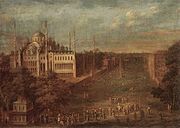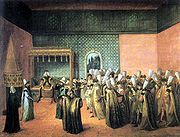
Jean-Baptiste van Mour
Encyclopedia



Flemish people
The Flemings or Flemish are the Dutch-speaking inhabitants of Belgium, where they are mostly found in the northern region of Flanders. They are one of two principal cultural-linguistic groups in Belgium, the other being the French-speaking Walloons...
-French
France
The French Republic , The French Republic , The French Republic , (commonly known as France , is a unitary semi-presidential republic in Western Europe with several overseas territories and islands located on other continents and in the Indian, Pacific, and Atlantic oceans. Metropolitan France...
painter, remembered for his detailed portrayal of life in the Ottoman Empire
Ottoman Empire
The Ottoman EmpireIt was usually referred to as the "Ottoman Empire", the "Turkish Empire", the "Ottoman Caliphate" or more commonly "Turkey" by its contemporaries...
during the Tulip Era
Tulip Era in the Ottoman Empire
The Tulip Period or Tulip Era is a period in Ottoman history from The Treaty of Passarowitz on 21 July 1718 to The Patrona Halil Rebellion on 28 September 1730...
and the rule of Sultan
Ottoman Dynasty
The Ottoman Dynasty ruled the Ottoman Empire from 1299 to 1922, beginning with Osman I , though the dynasty was not proclaimed until Orhan Bey declared himself sultan...
Ahmed III
Ahmed III
Ahmed III was Sultan of the Ottoman Empire and a son of Sultan Mehmed IV . His mother was Mâh-Pâre Ummatullah Râbi'a Gül-Nûş Valide Sultan, originally named Evmania Voria, who was an ethnic Greek. He was born at Hajioglupazari, in Dobruja...
.
Biography
Van Mour was a native of ValenciennesValenciennes
Valenciennes is a commune in the Nord department in northern France.It lies on the Scheldt river. Although the city and region had seen a steady decline between 1975 and 1990, it has since rebounded...
, a Flemish town that at he time of his birth belonged to the Spanish Netherlands, but since 1678 to France. He studied art in the studio of Jacques-Albert Gérin, and his work attracted the attention of an aristocrat and statesman of the time, Marquis Charles de Ferriol
Charles de Ferriol
Charles de Ferriol was a French ambassador sent by Louis XIV to the Ottoman Empire from 1699 to 1711, during the rule of Sultan Ahmed III....
. Van Mour was invited to go to Istanbul
Istanbul
Istanbul , historically known as Byzantium and Constantinople , is the largest city of Turkey. Istanbul metropolitan province had 13.26 million people living in it as of December, 2010, which is 18% of Turkey's population and the 3rd largest metropolitan area in Europe after London and...
when De Ferriol was appointed there as the French Ambassador in 1699. De Ferriol commissioned van Mour to do one hundred portraits of the local people.
In 1711 De Ferriol returned to France and van Mour worked for a variety of other diplomats. In the meantime De Ferriol published a series of one hundred engraving
Engraving
Engraving is the practice of incising a design on to a hard, usually flat surface, by cutting grooves into it. The result may be a decorated object in itself, as when silver, gold, steel, or glass are engraved, or may provide an intaglio printing plate, of copper or another metal, for printing...
s (after the paintings) in Recueil de cent estampes représentant différentes nations du Levant. The book had a great influence in Western Europe and was published in at least five languages.
Painting audiences with the Sultan became van Mour's speciality; he only had to change the setting and a few faces. Van Mour worked with assistants to fulfill all his obligations. In 1725 he was granted the extraordinary title of Peintre Ordinaire du Roy en Levant in recognition of both his and the Levant's importance to the French government.
In 1727 the Dutch ambassador Cornelis Calkoen asked Van Mour to record his audience with Sultan Ahmed III on canvas. Van Mour was allowed to enter the palace during these ceremonies accompanying the ambassador and his retinue; therefore, he was familiar with the special protocol that prevailed in the Ottoman court for ambassador's receptions. Calkoen took many paintings of Jean-Baptiste van Mour with him, when he was appointed as ambassador in Dresden
Dresden
Dresden is the capital city of the Free State of Saxony in Germany. It is situated in a valley on the River Elbe, near the Czech border. The Dresden conurbation is part of the Saxon Triangle metropolitan area....
for the Dutch Republic
Dutch Republic
The Dutch Republic — officially known as the Republic of the Seven United Netherlands , the Republic of the United Netherlands, or the Republic of the Seven United Provinces — was a republic in Europe existing from 1581 to 1795, preceding the Batavian Republic and ultimately...
. In his will of 1762 the bachelor Calkoen forbade his heirs to sell the paintings, which are now part of the Rijksmuseum
Rijksmuseum
The Rijksmuseum Amsterdam or simply Rijksmuseum is a Dutch national museum in Amsterdam, located on the Museumplein. The museum is dedicated to arts, crafts, and history. It has a large collection of paintings from the Dutch Golden Age and a substantial collection of Asian art...
collection.
It is said Van Mour was buried next to Baron de Salagnac in the graveyard of the Jesuit Church of St Louis in the district of Galata
Galata
Galata or Galatae is a neighbourhood in the Beyoğlu district on the European side of Istanbul, the largest city of Turkey. Galata is located at the northern shore of the Golden Horn, the inlet which separates it from the historic peninsula of old Constantinople. The Golden Horn is crossed by...
.

